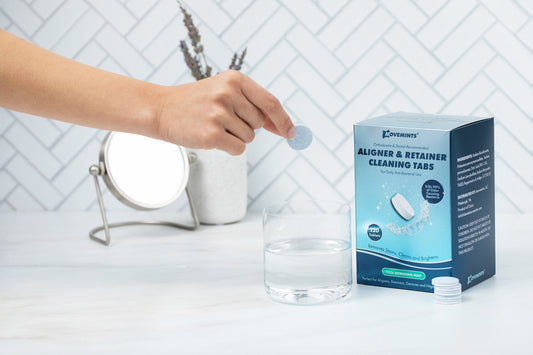Why Are My Teeth Not Tracking With My Invisalign Plan?
Straightening your teeth requires a significant investment of time, effort and money, so patients track the movement of their teeth on a regular basis. Invisalign progress is important to everyone involved, so it doesn't surprise me when people complain that their Invisalign is not tracking according to their treatment plan.
When you find your Invisalign not tracking, it can be frustrating. Fortunately we can get patients back on track with focused attention and extra effort. In this blog, I share five reasons why your Invisalign is not tracking and what you can do to get back on schedule.
What is Clear Aligner Tracking?
Before we get into our tips, let's review how Invisalign works and what we mean by “teeth tracking” so you can better understand the advice I’m about to share.
Tracking describes how teeth move in accordance with your treatment plan. We can’t straighten your teeth overnight, but through gradual and successive force we can move your teeth into a new position, and train them to stay there. With every new set of trays, we continue to repeat this gradual process of movement, training, and moving again until we achieve a smile you can be proud of.
Orthodontic professionals work with incredibly sophisticated systems to design your treatment plan. Software like ClinCheck creates an incredibly precise representation of the size, shape, and position of your teeth and defines how they will gradually move into their new positions. In cases of Invisalign gone wrong, we can institute mid-course corrections during treatment, or refinements after treatment to produce an end result that reflects your ideal smile.
So then why are your teeth not tracking? There are five common reasons that we can share here in this blog, but if you are really concerned about your progress it is always best to consult your orthodontist or provider.
My Invisalign is Not Tracking Because: Individual differences
Our computer models run thousands of scenarios to devise your treatment plan. These models account for common variables but they are unable to predict individual differences that result from your body’s specific response to orthodontic treatment. Plain and simple, some teeth are more stubborn than others, and when they aren't tracking it becomes one of the primary reasons why Invisalign doesn't work.

For example, your lateral incisors (the small teeth next to your two front teeth) are the most difficult teeth to move even with metal braces. If you’ve got some stubborn teeth, your provider may apply Invisalign attachments or buttons onto these teeth to give them more attention and encourage them to track in accordance with the plan. Once affixed, the buttons will be used to anchor rubber bands that can apply extra force to move those teeth.
My Invisalign is Not Tracking Because: Your teeth are colliding during treatment
If you’ve ever ridden public transportation during rush hour, you know how difficult it can be for crowds of people to squeeze through an open door. After a bit of bumping, grinding, and shuffling, people eventually get on the train, but not after a good bit of contact with each other.
Invisible braces can create the same crowding effect in your mouth, albeit on a much smaller scale. When two teeth are colliding with each other during treatment, your provider uses a solution called interproximal reduction, or IPR. These procedures are typically performed in the office, where your orthodontist will literally reshape your teeth to avoid collisions. But don’t worry! IPR is a safe and effective way of making more space so that your teeth can be straightened.
My Invisalign is Not Tracking Because: You aren't meeting the 22 hours of daily wear time
Even with the best intentions, many patients find it difficult to comply with the 22 hours of daily wear time that Invisalign and other at home clear aligner companies recommend. The fact is, it’s tough to find 22 hours in a day to wear invisible braces. And ironically, it’s the flexibility to remove trays during those two (ish) hours that can leave your teeth still crooked after Invisalign, leading to refinements and mid-course corrections during your treatment.
To minimize the variables introduced by removing your trays and help you achieve the 22 hours of wear time, we recommend TrayMinder’s free smartphone app to keep a record of your smile journey. It has a timer that tracks “not wearing” time and a reminder function that will help you set a limit for your trays being out. Or if you really want an all-in-one solution, check out nCase, a "smart" retainer case and mobile app that makes tracking your daily wear time much simpler.
My Invisalign is Not Tracking Because: You aren't doing your chewing exercises
Aligners work by creating orthodontic tooth movement that guides your teeth into their new positions. The trays “push” your teeth each time they are seated, which provides extra force for moving your teeth. So getting from the first tray to your last is really a numbers game; every time you swallow, your teeth come together and your trays tighten. Every time you clench your teeth due to stress or determination, you tighten your trays. However, swallowing and clenching only applies force to your molars, and not to your front teeth. Go ahead and try to swallow; where do you feel the pressure?
To apply seating pressure to your front teeth, perform the chewing exercises recommended by Invisalign specialists all over the world. I tell all my patients to do them 3-5 times each day, for 3-5 minutes per time, focusing on those front six teeth that don’t get the natural seating your molars enjoy. Chewing exercises will help deliver more predictable results because you’re giving your teeth that extra motivation to move, and you can do them in a couple ways.
First, you can use a chewie, small foam tubes you bite on several times until those aligners click into place. They do the job, but aren't the best look in public. That's why I created Movemints, a great tasting mint with a patented groove that seats your trays.
Place Movemints between your teeth with aligners in, and use gentle pressure until you feel your trays click into place. Repeating this process can also help reduce Invisalign pain while keeping you on track for the results you and your provider are hoping for.
My Invisalign is Not Tracking Because: My trays are getting gross and I don't want to wear them
If you don't wear them as required, they're not going to move your teeth. And if they're gross and dirty, you're not going to want to wear them. Keeping Invisalign braces clean and clear is top of mind for many patients, and for good reason. From a basic hygiene perspective, clean trays reduce the potential for cavities and will keep them (and your breath) from smelling funky and unappealing. Clean trays are also clearer and free of any ecru or eggshell tint which will make them more noticeable while you wear them.
We have an entire blog dedicated to keeping your clear aligners clean and clear, but there's one important point that we need to reinforce here that can prevent potential tracking issues: Don't make a habit of cleaning your trays with hot water. It will weaken the tensile strength and ultimately warp your trays. Even if you don’t think this is happening, the precision of your 3D printed invisible braces is so important to your treatment that even minor, imperceptible alterations can throw everything out of whack.
Stay positive!
Remember that the smile journey is a process, and even with advanced technology, 3D printed trays, and the best possible care, there will be things that don’t always go according to plan. A few adjustments along the way might add some time to your treatment, but isn’t it worth it to get the smile you’ve always wanted?
Starting your clear aligner treatment is an incredibly exciting time! Follow our blog for more Invisalign tips and tricks that will help you on the road to your ideal smile!





